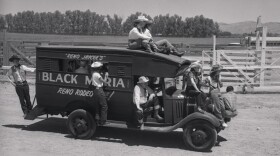The Reno Rodeo kicked off this week for its 100th year. KUNR is covering the anniversary with several stories, including excerpts from a multimedia project called Reno Rodeo 100. For the project, locals have been sharing their memories of the rodeo during open mic nights. They include Guy Clifton, who has written a book about the event’s history. Today, he explains how the rodeo first began a century ago.
In 1919, the Reno Rodeo opened its gates for the first time. The Reno Rodeo Association began as a committee from the Commercial Club of Reno, which was what the Chamber of Commerce was called at that time. The officials of the Commercial Club ended up being the first rodeo committee, including: Bill Moffit, the president of the Union Land and Cattle Company; John C. Durham, a Chevrolet dealer in town; George Wingfield of the Reno National Bank; and Charles Mapes Senior, who was a land owner and banker.
Another interesting addition to the team was Glen Hearst, a former newspaper man who managed the Grand Theater downtown. Hearst was tasked with coming up with entertainment for the rodeo during prohibition, so he set up an old Western town with art on the walls and entertainment inside.
“He decided on a place he called ‘Stingery Gulch’, which was nicknamed after a place in Rawhide, which was a red light district. The rodeo version had a dance hall on each end and entertainment, and they asked a couple of artists to do the decorations for it," said Clifton.
https://vimeo.com/249356904">The First Reno Rodeo from https://vimeo.com/jessilemay">Jessi LeMay on Vimeo.
Glen Hurst was sent to San Francisco, and then Salinas, as they held their rodeos. He recruited the whole team from the Salinas Rodeo, which had started in 1911, to come here and start the Reno Rodeo. The arena was built at the racetrack. They modeled the first rodeo after Salinas, Calgary and Pendleton to make it the best version they could come up with and become what they billed as the Best Rodeo in The West. Bill Brian was the first rodeo boss, and the first announcer was Butch Beaver. They also had a wild horse race, where they brought literal wild horses from a range from Lovelock to race.
“There were also famous bucking horses brought in, Glass Eye and Coyote, which, if you ever see old rodeo postcards, you will see those old broncs on there," Clifton said.
They also had a "college-educated bull" called Lord Ronald, who hailed from the University of California, Davis agriculture station. He bucked off all riders so was said to be smarter than any riders.
“The first champion was a guy named Hippy Burmeister," Clifton said. "His claim to fame was that he was a founding board member and the first president of the Rodeo Hall of Fame in Oklahoma City. Some trophies and photos from Reno Rodeo are still there."
After the first Reno Rodeo in 1919, the Reno Evening Gazette said, "The rodeo should be made an annual event. It should continue in the hands of volunteers, citizens who have started the ball rolling."
Clifton says that after 99 years, it's good to see that it still is.
The Reno Rodeo 100 project is a community partnership between the Reno Rodeo Association and the Reno Rodeo Foundation produced by Jessi LeMay. To see more of KUNR's coverage of the 2019 Reno Rodeo, visit Spurs & Mud: A Century of Reno Rodeo.







